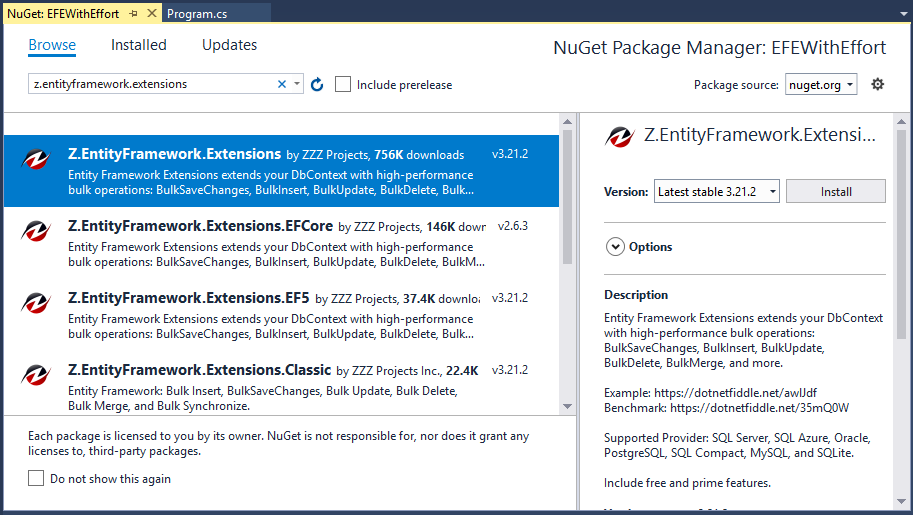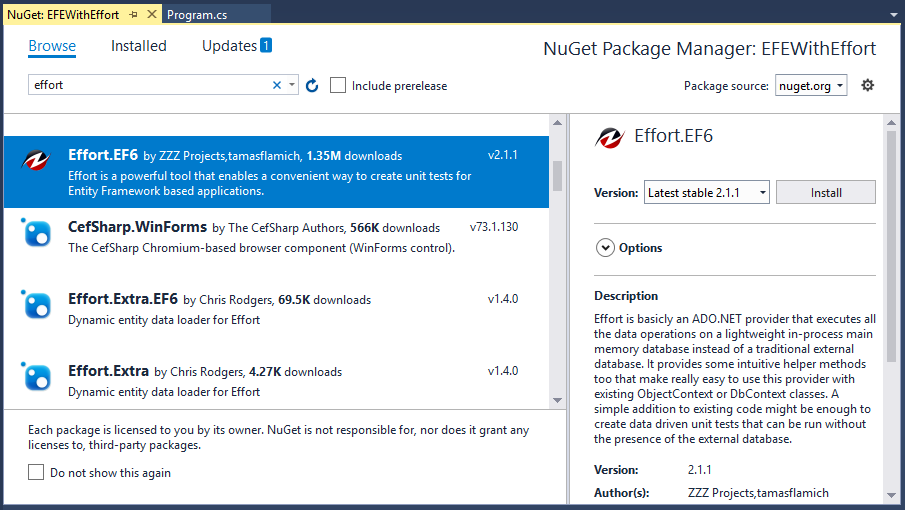EF6 - Effort Provider
Effort (Entity Framework Fake ObjectContext Realization Tool) is the official In-Memory provider for Entity Framework Classic.
- It creates a fake or mock database that allows you to test the Business Logic Layer (BLL) without worrying about your Data Access Layer (DAL).
- It is an ADO.NET provider that executes all the data operations on a lightweight in-process main memory database instead of a traditional external database.
- PostgreSQL requires very minimal maintenance effort because of its stability.
Install EFE
Let's create a new application using the Console App (.NET Framework) template and install Z.EntityFramework.Extensions.
Entity Framework Extensions (EFE) library is available as a NuGet package and you can install it using NuGet Package Manager.
In the Package Manager Console window, enter the following command.
PM> Install-Package Z.EntityFramework.Extensions
You can also install EFE by right-clicking on your project in Solution Explorer and selecting Manage NuGet Packages....

Search for Z.EntityFramework.Extensions and install the latest version by pressing the install button.
Install Effort
Install the Effort.EF6 NuGet package by using the following command in Package Manager Console window.
PM> Install-Package Effort.EF6
Similarly, you can also install Effort.EF6 by right-clicking on your project in Solution Explorer and select Manage Nuget Packages....

Search for Effort.EF6 and install the latest version by pressing the install button.
You are now ready to start your application.
Create Data Model
The model is a collection of classes to interact with the database.
- A model stores data that is retrieved according to the commands from the Controller and displayed in the View.
- It can also be used to manipulate the data to implement the business logic.
To create a data model for our application, we will start with the following two entities.
public class Author { public int AuthorId { get; set; } public string FirstName { get; set; } public string LastName { get; set; } public DateTime BirthDate { get; set; } public List<Book> Books { get; set; } } public class Book { public int BookId { get; set; } public string Title { get; set; } public Author Author { get; set; } }
There's a one-to-many relationship between Author and Book entities. In other words, an author can write any number of books, and a book can be written by only one author.
Create Database Context
The database context class provides the main functionality to coordinate Entity Framework with a given data model.
- You create this class by deriving from the
System.Data.Entity.DbContextclass. - In your code, you specify which entities are included in the data model.
- You can also customize certain Entity Framework behaviors.
So, let's add a new EntityContext class which will inherit the DbContext class.
public class EntityContext : DbContext { public EntityContext() { } public EntityContext(DbConnection connection) : base(connection, true) { } public DbSet<Author> Authors { get; set; } public DbSet<Book> Books { get; set; } }
This code creates a DbSet property for each entity set. In Entity Framework terminology, an entity set typically corresponds to a database table, and an entity corresponds to a row in the table.
Now, we are done with the required classes, to use Effort, you need to create a transient connection and use it for our context.
DbConnection connection = Effort.DbConnectionFactory.CreateTransient(); Z.EntityFramework.Extensions.EntityFrameworkManager.ContextFactory = context => new EntityContext(connection); var context = new EntityContext(connection);
We are using a special connection, so we also need to let Z.EntityFramework.Extensions library also know how to create a context by setting the EntityFrameworkManager.ContextFactory.
Now, let's add some author and book records to the database and then retrieve it.
DbConnection connection = Effort.DbConnectionFactory.CreateTransient(); Z.EntityFramework.Extensions.EntityFrameworkManager.ContextFactory = context => new EntityContext(connection); using (var context = new EntityContext(connection)) { context.Database.CreateIfNotExists(); var authors = new List<Author> { new Author { FirstName ="Carson", LastName ="Alexander", BirthDate = DateTime.Parse("1985-09-01"), Books = new List<Book>() { new Book { Title = "Introduction to Machine Learning"}, new Book { Title = "Advanced Topics in Machine Learning"}, new Book { Title = "Introduction to Computing"} } }, new Author { FirstName ="Meredith", LastName ="Alonso", BirthDate = DateTime.Parse("1970-09-01"), Books = new List<Book>() { new Book { Title = "Introduction to Microeconomics"} } }, new Author { FirstName ="Arturo", LastName ="Anand", BirthDate = DateTime.Parse("1963-09-01"), Books = new List<Book>() { new Book { Title = "Calculus I"}, new Book { Title = "Calculus II"} } } }; context.BulkInsert(authors, options => options.IncludeGraph = true); } using (var context = new EntityContext()) { var list = context.Authors .Include(a => a.Books) .ToList(); foreach (var author in list) { Console.WriteLine(author.FirstName + " " + author.LastName); foreach (var book in author.Books) { Console.WriteLine("\t" + book.Title); } } }
If you run the application, you will see that author entities are successfully inserted into the database.
ZZZ Projects